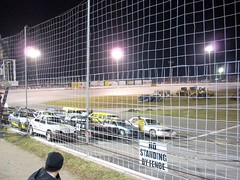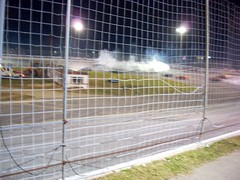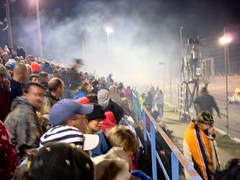All of my male friends expressed keen interest in joining me for this absurd treat, but it fell on the day after Thanksgiving. Most of those who are married had houses full of family staying for the weekend, so despite pitiful begging, they couldn’t get their wives to let them out for one night. I wound up going alone.
The parking lot for the track is a gigantic empty field, and it was filled almost to capacity when I arrived, seven minutes before the show was about to start. To my dismay, there was a huge line of people waiting to get in. Just then, a man approached the line, pointed and announced, “If you have exact change, we’ve opened another entrance just over there.” Thirty people, including myself, bolted for the second entrance. I was admitted to the track within a minute.
The track has two grandstands, one along the side where I entered, and another on the far side. The stands on my side were packed, but the stands on the far side only had a few people in them. I walked over to the other side, and found a mob of people crushed together in front of a small gate. Track officials were admitting people one by one, and requiring them to pay an extra $5 for seating. Disgusted, I walked back to the other side of the track.
As I approached the center of the grandstand, I noticed an empty space between two people in the front row. I couldn’t believe my luck. I was able to grab one of the best seats in the house, only about 15 feet from the finish line. The only bad thing about it was the safety screen, designed to protect the people in the grandstand from flying auto parts, and believe me, there were going to be lots of flying auto parts. It wasn’t an obstruction for me personally, but it did hinder photography.

This particular track is only a quarter-mile long, with banked turns. It can be configured for lots of different events. The first race was a standard race, but using junkyard-ready cars on a kidney-shaped track arrangement. Adding the tight chicane meant that there would be lots of vehicle contact, and there was. The race was won by the car that avoided the other cars most successfully.

The next two events were called “Roller Derby” races. The race is run by teams of drivers, three cars to a team. The car in front is called the “puck car,” and it’s not running. The driver can only steer and brake. The next car is called the “pusher car.” The driver of that car attempts to push the “puck car” around the track for the specified number of laps. The third car is the “enforcer car.” The job of the “enforcer” is to keep other “enforcers” away from his team’s “puck-pusher” combination, or to disrupt the “puck-pusher” combination of other teams. By “disrupt,” I mean “destroy.” This race is run on an oval track.

As you can just tell from this photo, there was plenty of carnage. Some “pusher cars” wound up pushing mangled wrecks around the track, with what I suppose were mangled drivers in them. Kids, if you want to grow up and be a race car driver, try not to drive the "puck car."

I was impressed by this driver (the "enforcer" of the winning team), who drove a modified hearse with some kind of plow welded to the front, completing the entire race with a cigarette hanging out of his mouth.

The next race was something called a “Skid Race,” once again on an oval track. In this event, each car was a front-wheel drive vehicle. The rear wheels were mounted on a pair of metal skis, which threw up a giant rooster-tail of sparks. The cars fishtailed all over the track, pinwheeling out of control at the slightest bump or steering error.
After the “Skid Race,” they set the track up for a “Flagpole Race.” In this event, a “pole” (actually just a junk car) was set up in the infield, just at the center of one straightaway. Cars raced around the track, then had to careen around the pole and reenter traffic. “That’s where it gets tricky,” said the announcer, a master of understatement. Cars often had to circle very wide around the pole, because of all the wrecked or disabled vehicles surrounding it.

Just before intermission, an unusual vehicle was brought out onto the track. It’s a jet-powered car called Green Mamba. This car is capable of going 300 miles per hour, but it’s nearly useless on a quarter-mile track. It crept slowly around the oval, and on each straightaway, the driver would enrich the mixture and belch a 30-foot tail of flame to amuse the children.

The announcer promised that at the end of the show, Green Mamba would return, and they would use it as a gigantic blowtorch to “burn a bus.” That sounded quite spectacular, but it’s not why I was there.
Finally, they set up for the event I came to see: The Figure-8 Track School bus Race. Twelve junk school busses drove onto the track, which was set up in a figure-8 configuration.

When the race started, the busses were in a fairly tight group. But after the third lap, they had spread out to the point where almost every bus approaching the intersection had to thread the needle between other busses crossing in front of them. There were moments of gut-wrenching terror. Eventually, the inevitable happened, and two busses collided. The bus that was struck rolled completely over, and officials stopped the race to verify that the driver was alive (he was).
There were lots of personnel on the track, used to remove debris between events. They were safely tucked away behind concrete barricades set up in the infield portions of the figure-8. However, one ambulance and one tow truck were parked outside these safe havens, so that they could render aid quickly, if necessary. Some young people lounged on the back of the tow truck, chatting – they had seen lots of these races. Suddenly, two busses collided in the intersection, and one of them careened out of control directly at the tow truck. The faces on the young people were priceless, as they suddenly realized they were about to become part of the show. Fortunately, the driver of the bus was able to recover and slam on the brakes at the last instant, bringing the bus to a screeching, smoking halt inches from the tow truck.
After that exciting spectacle, the track ran a “Boat and Trailer Race” on an oval track. Each vehicle had to tow a boat on a trailer, and to win, had to finish with at least a partial boat or a partial trailer. So the obvious strategy was to demolish the other boats. One guy showed up with a monster truck pulling a cabin cruiser. He was good at demolition, but too slow to win. Boats on trailers don’t corner well, so there was a lot of wreckage on the track after only a couple of laps, and the vehicles that were left were crashing into the wreckage at high speed. The carnage generated a lot of choking smoke, which seemed to delight the crowd.

The final race of the evening was what’s called a “Camper Trailer Race.” In this race, each vehicle must tow some kind of camper trailer or house trailer. One guy had a house trailer with a Christmas tree set up. When it started to fall apart, it dumped a gas stove onto the track.
By then, I was so jaded from this orgy of destruction, I decided to leave rather than hang around for the bus-burning. It's hard to drive a car after you've been watching this kind of thing. I was mentally daring someone to cut me off. Especially if they were towing a boat.
